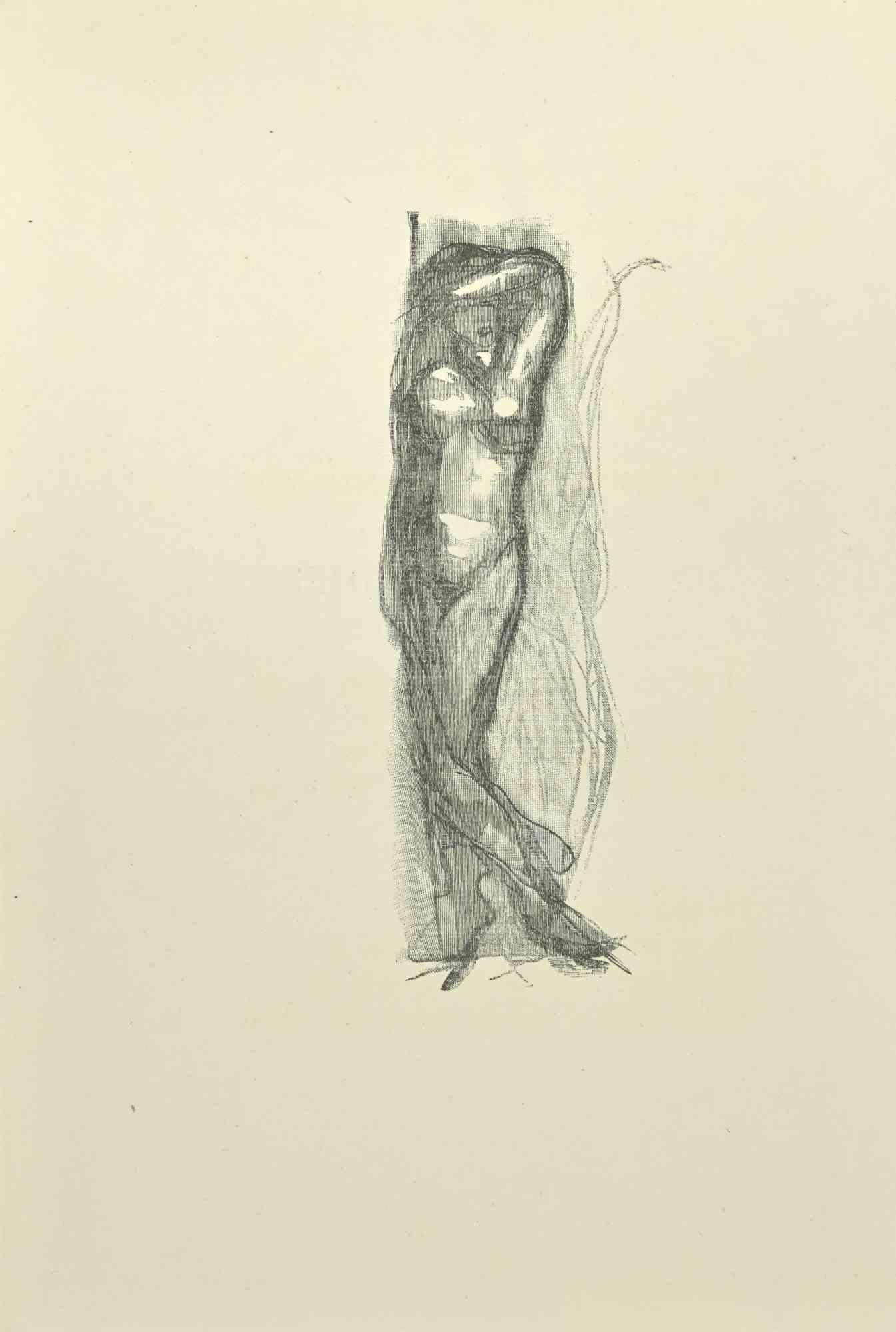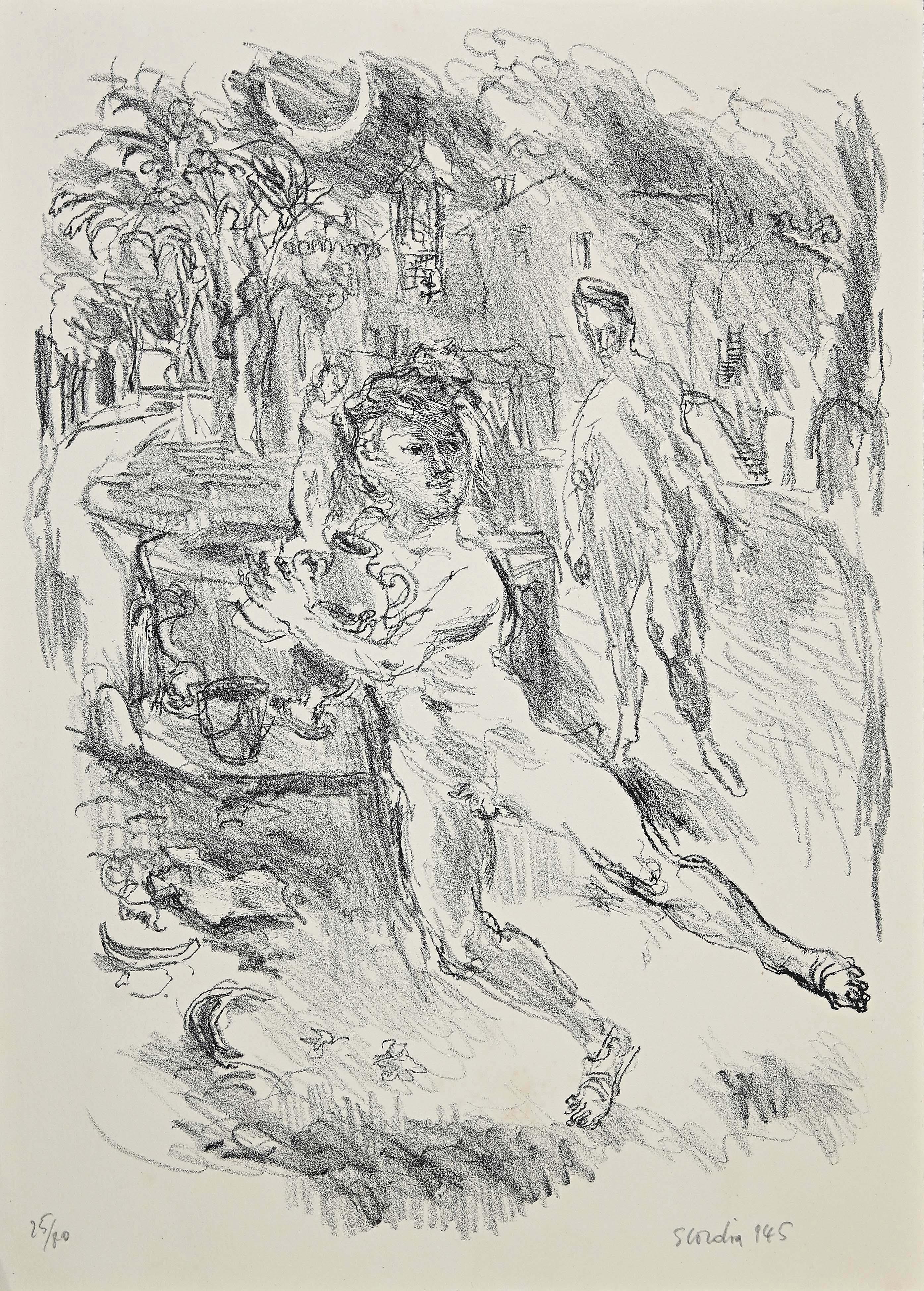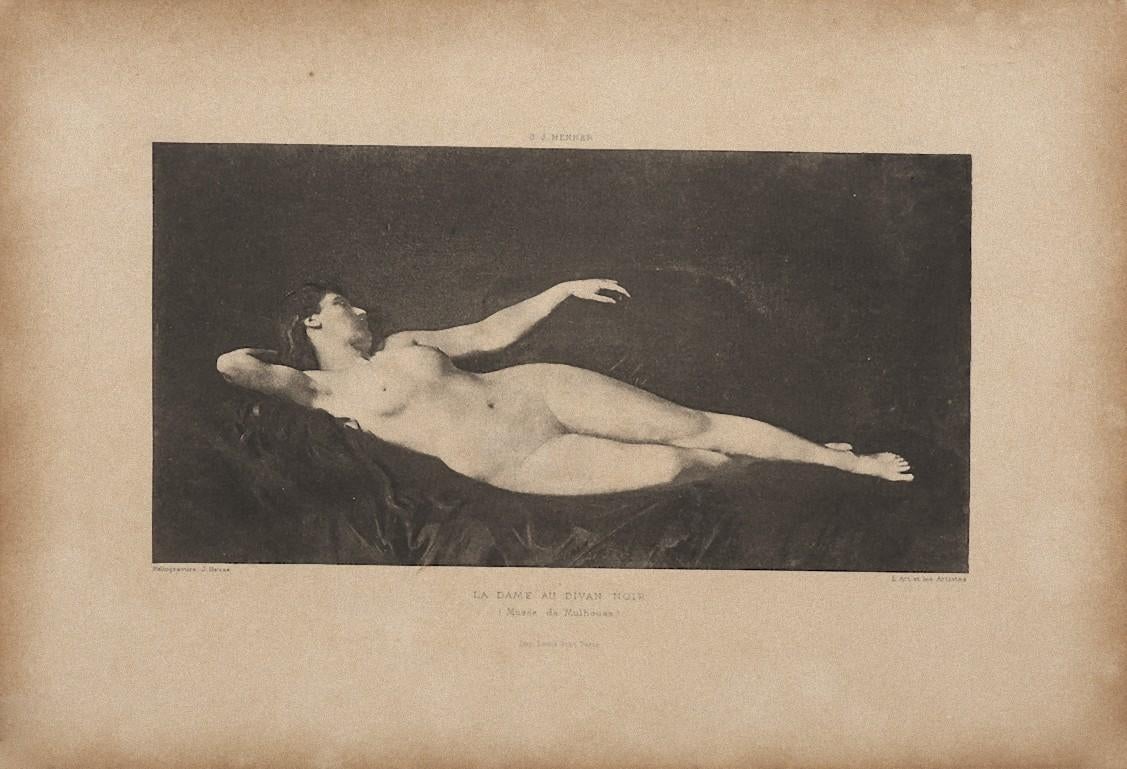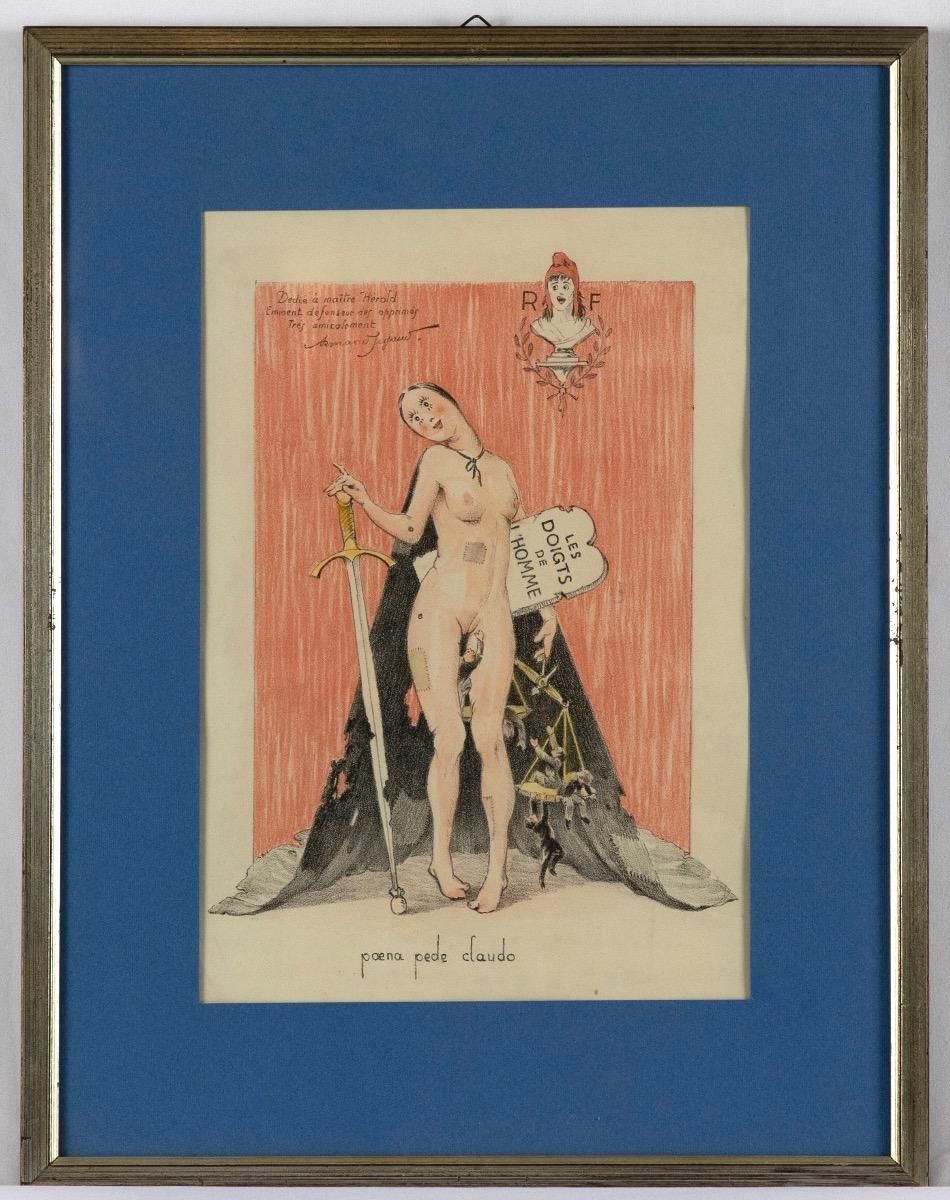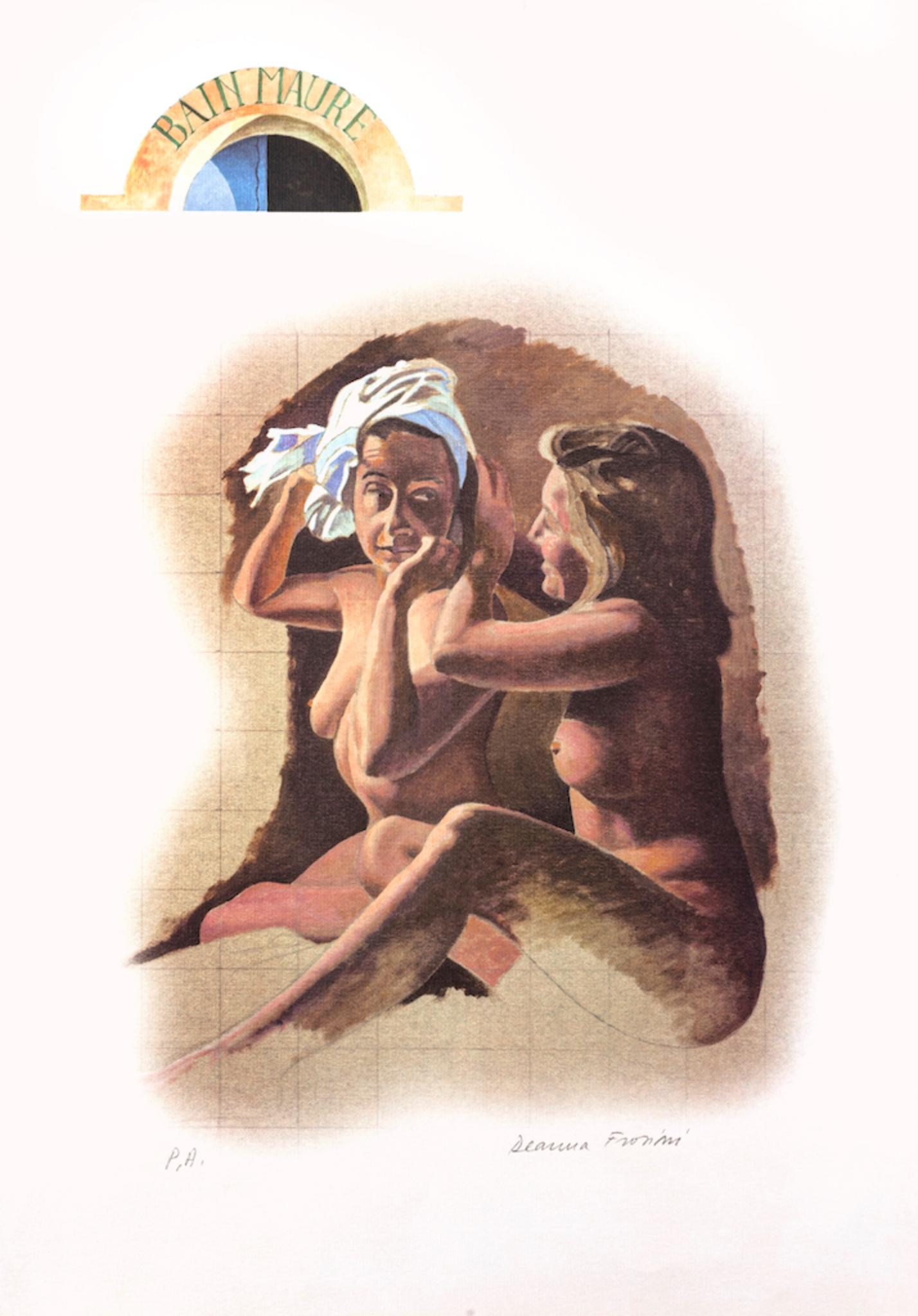Items Similar to after Pablo Picasso - The Human Comedy - Heliogravure
Want more images or videos?
Request additional images or videos from the seller
1 of 9
(after) Pablo Picassoafter Pablo Picasso - The Human Comedy - Heliogravure1954
1954
About the Item
A vintage heliogravure after Spanish artist Pablo Picasso (1881-1973) titled "La Comedie Humaine", 1954.
Published by Verve, Paris France 1954.
Produced from Picasso's sketches from the series entitled "La Comedie Humaine". Picasso authorized and was commissioned to see these heliogravures produced. Dated in the plate.
Dimensions: 9.5" x 12.25".
Excellent condition.
Pablo Picasso
Picasso is not just a man and his work. Picasso is always a legend, indeed almost a myth. In the public view he has long since been the personification of genius in modern art. Picasso is an idol, one of those rare creatures who act as crucibles in which the diverse and often chaotic phenomena of culture are focussed, who seem to body forth the artistic life of their age in one person. The same thing happens in politics, science, sport. And it happens in art.
Early life
Born in Malaga, Spain, in October of 1881, he was the first child born in the family. His father worked as an artist, and was also a professor at the school of fine arts; he also worked as a curator for the museum in Malaga. Pablo Picasso studied under his father for one year, then went to the Academy of Arts for one year, prior to moving to Paris. In 1901 he went to Paris, which he found as the ideal place to practice new styles, and experiment with a variety of art forms. It was during these initial visits, which he began his work in surrealism and cubism style, which he was the founder of, and created many distinct pieces which were influenced by these art forms.
Updates in style
During his stay in Paris, Pablo Picasso was constantly updating his style; he did work from the blue period, the rose period, African influenced style, to cubism, surrealism, and realism. Not only did he master these styles, he was a pioneer in each of these movements, and influenced the styles to follow throughout the 20th century, from the initial works he created. In addition to the styles he introduced to the art world, he also worked through the many different styles which appeared, while working in Paris. Not only did he continually improve his style, and the works he created, he is well known because of the fact that he had the ability to create in any style which was prominent during the time.
Russian ballet
In 1917, Pablo Picasso joined the Russian Ballet, which toured in Rome; during this time he met Olga Khoklova, who was a ballerina; the couple eventually wed in 1918, upon returning to Paris. The couple eventually separated in 1935; Olga came from nobility, and an upper class lifestyle, while Pablo Picasso led a bohemian lifestyle, which conflicted. Although the couple separated, they remained officially married, until Olga's death, in 1954. In addition to works he created of Olga, many of his later pieces also took a centralized focus on his two other love interests, Marie Theresa Walter and Dora Maar. Pablo Picasso remarried Jacqueline Roque in 1961; the couple remained married until his death 12 years later, in 1973.
Work as a pacifist
Pablo Picasso was a pacifist, and large scale paintings he created, showcased this cry for peace, and change during the time. A 1937 piece he created, after the German bombing of Guernica, was one such influential piece of the time. Not only did this become his most famous piece of art work, but the piece which showed the brutality of war, and death, also made him a prominent political figure of the time. To sell his work, and the message he believed in, art, politics, and eccentricity, were among his main selling points.
Conflicting with social views
Many things Pablo Picasso did during the 1950s, conflicted with the general public. Viciousness towards his children, exaggerated virility towards women, and joining the Communist party, were some of the many scandals which he was involved in during his lifetime. Although most of the things he did were viewed negatively by a minority of the general public, admirers of Pablo Picasso turned a blind eye, and still accepted him as a prominent figure in their society. Following the end of WWII, Pablo Picasso turned back towards his classic style of work, and he created the "Dove of Peace." Even though he became a member of the Communist party, and supported Stalin and his political views and rule, Pablo Picasso could do no wrong. In the eyes of his admirers and supporters, he was still a prominent figure, and one which they would follow, regardless of what wrongs he did. He was not only an influence because of the works he created, but he was also an influential figure in the political realm.
Influence outside of art
Although Pablo Picasso is mainly known for his influence to the art world, he was an extremely prominent figure during his time, and to the 20th century in general. He spread his influences to the art world, but also to many aspects of the cultural realm of life as well. He played several roles in film, where he always portrayed himself; he also followed a bohemian lifestyle, and seemed to take liberties as he chose, even during the later stages of his life. He even died in style, while hosting a dinner party in his home.
Collection of work
Pablo Picasso is recognized as the world's most prolific painter. His career spanned over a 78 year period, in which he created: 13,500 paintings, 100,000 prints and engravings, and 34,000 illustrations which were used in books. He also produced 300 sculptures and ceramic pieces during this expansive career. It is also estimated that over 350 pieces which he created during his career, have been stolen; this is a figure that is far higher than any other artist throughout history.
Sale of his works
Pablo Picasso has also sold more pieces, and his works have brought in higher profit margins, than any other artist of his time. His pieces rank among the most expensive art works to be created; with a price tag of $104 million, Garson a la Pipe, was sold in 2004.
Although he had a conflicting lifestyle, Pablo Picasso was admired by many, and was one of the most influential figures of his time. Not only during his life, but also after his death, he is still one of the most well known artists, and political figures, of his time. With thousands of pieces to his name, and art works which have been seen by millions, around the world, he has been a great influence to society, he has influenced the art world, and he introduced many new styles of art, which helped shape modern art, and modern styles artists follow today.
- Creator:(after) Pablo Picasso (1881 - 1973, Spanish)
- Creation Year:1954
- Dimensions:Height: 12.25 in (31.12 cm)Width: 9.5 in (24.13 cm)Depth: 0.1 in (2.54 mm)
- Movement & Style:
- Period:
- Condition:
- Gallery Location:Collonge Bellerive, Geneve, CH
- Reference Number:1stDibs: LU16122113363
(after) Pablo Picasso
Pablo Picasso (1881 – 1973) was a Spanish painter, sculptor, printmaker, ceramicist, stage designer, poet and playwright who is regarded as one of the most influential artists of the 20th century. He is known for co-founding the Cubist movement, the invention of constructed sculpture, the co-invention of collage, and for the wide variety of styles that he helped develop and explore. Exceptionally prolific throughout the course of his long life, Picasso achieved universal renown and immense fortune for his revolutionary artistic accomplishments, and became one of the best-known figures in 20th-century art. The total number of artworks he produced has been estimated at around 50,000.
About the Seller
4.9
Gold Seller
These expertly vetted sellers are highly rated and consistently exceed customer expectations.
Established in 2015
1stDibs seller since 2015
910 sales on 1stDibs
Typical response time: 1 hour
- ShippingRetrieving quote...Ships From: Collonge Bellerive, Geneve, Switzerland
- Return PolicyA return for this item may be initiated within 7 days of delivery.
More From This SellerView All
- after Henri Matisse - AcrobatBy Henri MatisseLocated in Collonge Bellerive, Geneve, CHafter Henri Matisse - Acrobat Edition of 200 with the printed signature, as issued 76 x 56 With stamp of the Succession Matisse References : Artvalue - Succession MatisseCategory
1950s Modern Nude Prints
MaterialsLithograph
- Leonor Fini - Pride - Original LithographBy Leonor FiniLocated in Collonge Bellerive, Geneve, CHLeonor Fini - Pride - Original Lithograph The Flowers of Evil 1964 Conditions: excellent Edition: 500 Dimensions: 46 x 34 cm Editions: Le Cercle du Livre Précieux, Paris Unsigned a...Category
1960s Modern Nude Prints
MaterialsLithograph
- Leonor Fini - Saturday Night Dress - Original LithographBy Leonor FiniLocated in Collonge Bellerive, Geneve, CHLeonor Fini - Saturday Night Dress - Original Lithograph The Flowers of Evil 1964 Conditions: excellent Edition: 500 Dimensions: 46 x 34 cm Editions: Le Cercle du Livre Précieux, P...Category
1960s Modern Nude Prints
MaterialsLithograph
- Marc Chagall - Double Portrait - Original LithographBy Marc ChagallLocated in Collonge Bellerive, Geneve, CHMarc Chagall, Original Lithograph depicting an instant of the Bible. Technique: Original lithograph in colours Year: 1956 Sizes: 35,5 x 26 cm / 14" x 10.2" (sheet) Published by: Édit...Category
1950s Modern Figurative Prints
MaterialsLithograph
- Leonor Fini - Prisonners - Original LithographBy Leonor FiniLocated in Collonge Bellerive, Geneve, CHLeonor Fini - Prisonners - Original Lithograph The Flowers of Evil 1964 Conditions: excellent Edition: 500 Dimensions: 46 x 34 cm Editions: Le Cercle du Livre Précieux, Paris Unsig...Category
1960s Modern Nude Prints
MaterialsLithograph
- Marc Chagall - Moses - Original LithographBy Marc ChagallLocated in Collonge Bellerive, Geneve, CHMarc Chagall, Original Lithograph depicting an instant of the Bible. Technique: Original lithograph in colours Year: 1956 Sizes: 35,5 x 26 cm / 14" x 10.2" (sheet) Published by: Éditions de la Revue Verve, Tériade, Paris Printed by: Atelier Mourlot, Paris Documentation / References: Mourlot, F., Chagall Lithograph [II] 1957-1962, A. Sauret, Monte Carlo 1963, nos. 234 and 257 Marc Chagall (born in 1887) Marc Chagall was born in Belarus in 1887 and developed an early interest in art. After studying painting, in 1907 he left Russia for Paris, where he lived in an artist colony on the city’s outskirts. Fusing his own personal, dreamlike imagery with hints of the fauvism and cubism popular in France at the time, Chagall created his most lasting work—including I and the Village (1911)—some of which would be featured in the Salon des Indépendants exhibitions. After returning to Vitebsk for a visit in 1914, the outbreak of WWI trapped Chagall in Russia. He returned to France in 1923 but was forced to flee the country and Nazi persecution during WWII. Finding asylum in the U.S., Chagall became involved in set and costume design before returning to France in 1948. In his later years, he experimented with new art forms and was commissioned to produce numerous large-scale works. Chagall died in St.-Paul-de-Vence in 1985. The Village Marc Chagall was born in a small Hassidic community on the outskirts of Vitebsk, Belarus, on July 7, 1887. His father was a fishmonger, and his mother ran a small sundries shop in the village. As a child, Chagall attended the Jewish elementary school, where he studied Hebrew and the Bible, before later attending the Russian public school. He began to learn the fundamentals of drawing during this time, but perhaps more importantly, he absorbed the world around him, storing away the imagery and themes that would feature largely in most of his later work. At age 19 Chagall enrolled at a private, all-Jewish art school and began his formal education in painting, studying briefly with portrait artist Yehuda Pen. However, he left the school after several months, moving to St. Petersburg in 1907 to study at the Imperial Society for the Protection of Fine Arts. The following year, he enrolled at the Svanseva School, studying with set designer Léon Bakst, whose work had been featured in Sergei Diaghilev's Ballets Russes. This early experience would prove important to Chagall’s later career as well. Despite this formal instruction, and the widespread popularity of realism in Russia at the time, Chagall was already establishing his own personal style, which featured a more dreamlike unreality and the people, places and imagery that were close to his heart. Some examples from this period are his Window Vitebsk (1908) and My Fianceé with Black Gloves (1909), which pictured Bella Rosenfeld, to whom he had recently become engaged. The Beehive Despite his romance with Bella, in 1911 an allowance from Russian parliament member and art patron Maxim Binaver enabled Chagall to move to Paris, France. After settling briefly in the Montparnasse neighborhood, Chagall moved further afield to an artist colony known as La Ruche (“The Beehive”), where he began to work side by side with abstract painters such as Amedeo Modigliani and Fernand Léger as well as the avant-garde poet Guillaume Apollinaire. At their urging, and under the influence of the wildly popular fauvism and cubism, Chagall lightened his palette and pushed his style ever further from reality. I and the Village (1911) and Homage to Apollinaire (1912) are among his early Parisian works, widely considered to be his most successful and representative period. Though his work stood stylistically apart from his cubist contemporaries, from 1912 to 1914 Chagall exhibited several paintings at the annual Salon des Indépendants exhibition, where works by the likes of Juan Gris, Marcel Duchamp and Robert Delaunay were causing a stir in the Paris art world. Chagall’s popularity began to spread beyond La Ruche, and in May 1914 he traveled to Berlin to help organize his first solo exhibition, at Der Sturm Gallery. Chagall remained in the city until the highly acclaimed show opened that June. He then returned to Vitebsk, unaware of the fateful events to come. War, Peace and Revolution In August 1914 the outbreak of World War I precluded Chagall’s plans to return to Paris. The conflict did little to stem the flow of his creative output, however, instead merely giving him direct access to the childhood scenes so essential to his work, as seen in paintings such as Jew in Green (1914) and Over Vitebsk (1914). His paintings from this period also occasionally featured images of the war’s impact on the region, as with Wounded Soldier (1914) and Marching (1915). But despite the hardships of life during wartime, this would also prove to be a joyful period for Chagall. In July 1915 he married Bella, and she gave birth to a daughter, Ida, the following year. Their appearance in works such as Birthday (1915), Bella and Ida by the Window (1917) and several of his “Lovers” paintings give a glimpse of the island of domestic bliss that was Chagall’s amidst the chaos. To avoid military service and stay with his new family, Chagall took a position as a clerk in the Ministry of War Economy in St. Petersburg. While there he began work on his autobiography and also immersed himself in the local art scene, befriending novelist Boris Pasternak, among others. He also exhibited his work in the city and soon gained considerable recognition. That notoriety would prove important in the aftermath of the 1917 Russian Revolution when he was appointed as the Commissar of Fine Arts in Vitebsk. In his new post, Chagall undertook various projects in the region, including the 1919 founding of the Academy of the Arts. Despite these endeavors, differences among his colleagues eventually disillusioned Chagall. In 1920 he relinquished his position and moved his family to Moscow, the post-revolution capital of Russia. In Moscow, Chagall was soon commissioned to create sets and costumes for various productions at the Moscow State Yiddish...Category
1950s Modern Figurative Prints
MaterialsLithograph
You May Also Like
- Nude - Woodcut after Jean Paul Sauget - 1921Located in Roma, ITNude is a woodcut print print on paper, realized after Jean Paul Sauget for Maurice Magre's Les Soirs d'Opium. Published in 1921. Good conditions.Category
1920s Modern Figurative Prints
MaterialsWoodcut
- The Escape - Lithograph by Antonio Scordia - 1945By Antonio ScordiaLocated in Roma, ITThe Escape is an original lithograph artwork realized by Antonio Scordia in 1945. Edition of 25/80 prints. Hand-signed in pencil on the lower right; numbered on the lower left. Good conditions. The artwork represents two figures, in the front the nude one, resembles the Hermes, with his position of flying and his feet. The artwork is created through quick and confident strokes, in a well-balanced composition. Antonio Scordia (Santa Fè, Argentina, 1918 - Rome, 1988) was an Italian painter. In 1921, he moved to Rome with his family where he attended the School of the Academy of France...Category
1940s Modern Figurative Prints
MaterialsLithograph
- Nude - Lithograph signed "Heuse" - 1880 ca.Located in Roma, ITNude is an original lithograph signed "J. Heuse". Signed on plate on the lower left. Good condition except for some folding and being aged. The artwork represents a nude figure in...Category
1880s Modern Figurative Prints
MaterialsLithograph
- Poena Pede Claudo - Lithograph by Maurice Neumont - Early 20th CenturyBy Maurice NeumontLocated in Roma, IT"Poena pede claudo" is an original print in lithograph on paper realized by Maurice Neumont( 1868-1930). Titled on the lower center. The state of preservation of the artwork is go...Category
Early 20th Century Modern Nude Prints
MaterialsPaper, Lithograph
- Nude - Lithograph by Pericle Fazzini - 1958Located in Roma, ITNude is a fine lithograph on paper, realized by the Italian artist Pericle Fazzini in 1958. The print depicts a female nude posing. Hand signed and d...Category
1950s Modern Figurative Prints
MaterialsLithograph
- Hammam - Screen Print by Deanna Frosini - 1980sLocated in Roma, ITHammam is an original contemporary screen print on paper realized by Deanna Frosini. Hand-signed on the lower right and numbered. Good conditions. Sh...Category
1980s Modern Figurative Prints
MaterialsScreen
Recently Viewed
View AllMore Ways To Browse
After Vintage
Nude Ceramic
Nude Surrealism
The Wrong Man
Picasso Paintings For Sale
Nude Couple Painting
Sculpture Vintage Nude
War And Peace Picasso
Russian Ballerina
School For Scandal
Picasso Couple With Child
Blue Ballerina Painting
Picasso Blue Nude
Pablo Picasso Dora Maar
Picasso Human Comedy
Vintage French Ceramic Sculpture
Nude Sketchings By Famous Artists
Russian Rose Plate
